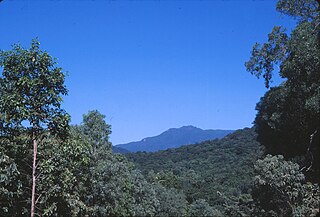
Mosses are small, non-vascular flowerless plants in the taxonomic division Bryophytasensu stricto. Bryophyta may also refer to the parent group bryophytes, which comprise liverworts, mosses, and hornworts. Mosses typically form dense green clumps or mats, often in damp or shady locations. The individual plants are usually composed of simple leaves that are generally only one cell thick, attached to a stem that may be branched or unbranched and has only a limited role in conducting water and nutrients. Although some species have conducting tissues, these are generally poorly developed and structurally different from similar tissue found in vascular plants. Mosses do not have seeds and after fertilisation develop sporophytes with unbranched stalks topped with single capsules containing spores. They are typically 0.2–10 cm (0.1–3.9 in) tall, though some species are much larger. Dawsonia, the tallest moss in the world, can grow to 50 cm (20 in) in height. There are approximately 12,000 species.

Bryophytes are a group of land plants, sometimes treated as a taxonomic division, that contains three groups of non-vascular land plants (embryophytes): the liverworts, hornworts and mosses. In the strict sense, Bryophyta consists of the mosses only. Bryophytes are characteristically limited in size and prefer moist habitats although they can survive in drier environments. The bryophytes consist of about 20,000 plant species. Bryophytes produce enclosed reproductive structures, but they do not produce flowers or seeds. They reproduce sexually by spores and asexually by fragmentation or the production of gemmae. Though bryophytes were considered a paraphyletic group in recent years, almost all of the most recent phylogenetic evidence supports the monophyly of this group, as originally classified by Wilhelm Schimper in 1879. The term bryophyte comes from Ancient Greek βρύον (brúon) 'tree moss, liverwort', and φυτόν (phutón) 'plant'.

The Marchantiophyta are a division of non-vascular land plants commonly referred to as hepatics or liverworts. Like mosses and hornworts, they have a gametophyte-dominant life cycle, in which cells of the plant carry only a single set of genetic information.

Moss Vale is a town in the Southern Highlands of New South Wales, Australia, in the Wingecarribee Shire. It is located on the Illawarra Highway, which connects to Wollongong and the Illawarra coast via Macquarie Pass.
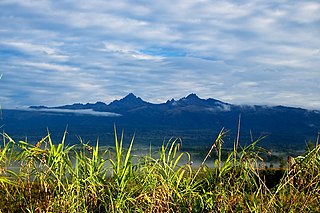
Mount Giluwe is the second highest mountain in Papua New Guinea at 4,367 metres (14,327 ft), and the fifth highest peak on the island of New Guinea. It is located in the Southern Highlands province and is an old shield volcano with vast alpine grasslands. Ancient volcanic plugs form its two summits, with the central peak the highest and an east peak about 2 kilometres (1.2 mi) away at 4,300 m (14,108 ft). Giluwe has the distinction of being the highest volcano on the Australian continent and Oceania, and is thus one of the Volcanic Seven Summits.

The Moss Landing Power Plant is a natural gas powered electricity generation plant located in Moss Landing, California, United States, at the midpoint of Monterey Bay. Its large stacks are landmarks, visible throughout the Monterey Bay Area. The plant is owned and operated by Houston-based Dynegy and currently has a generation capacity of 1020 MW (net) from its two combined cycle generation units. It was once the largest power plant in the state of California, with a generation capacity of 2560 MW, before its two large supercritical steam units were retired in 2016.

Lake Matheson is a small glacial lake in South Westland, New Zealand, near the township of Fox Glacier. It was a traditional food-gathering place for local Māori. An easy walking track circles the lake, which is famous for its reflected views of Aoraki / Mount Cook and Mount Tasman.
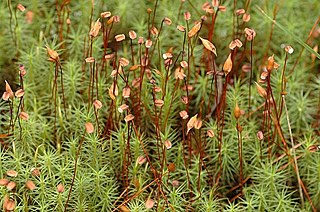
Polytrichaceae is a common family of mosses. Members of this family tend to be larger than other mosses with a thickened central stem and a rhizome. The leaves have a midrib that bears photosynthetic lamellae on the upper surface. Species in this group are dioicous. Another characteristic that identifies them is that they have from 32 to 64 peristome teeth in their sporangium.
Lepidopilum is a genus of moss in family Pilotrichaceae. There are over 200 species in the genus.
Paleontology or palaeontology is the study of prehistoric life forms on Earth through the examination of plant and animal fossils. This includes the study of body fossils, tracks (ichnites), burrows, cast-off parts, fossilised feces (coprolites), palynomorphs and chemical residues. Because humans have encountered fossils for millennia, paleontology has a long history both before and after becoming formalized as a science. This article records significant discoveries and events related to paleontology that occurred or were published in the year 1947.

Dawsonia is a genus of acrocarpous mosses. Dawsonia, along with other members of the order Polytrichales, are taller than most mosses and have thicker leaves. Their sporophytes have conducting systems analogous to those of vascular plants. Dawsonia superba is found in New Zealand, Australia and New Guinea. D. longifolia is found in the Philippines, Indonesia, Malaysia, and Australia. There is uncertainty as to whether D. superba and D. longifolia are actually distinct species.

Dawsonia longifolia is a tall moss, growing to ~60 cm in height. This species may be a synonym of D. superba.
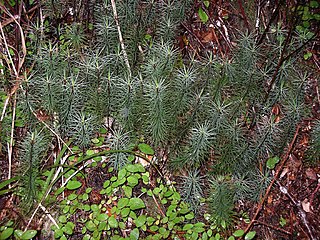
Dawsonia superba is a moss in the class Polytrichaceae that is found in Australia, New Guinea, Malaysia and New Zealand. D. superba is the tallest self-supporting moss in the world, reaching heights of 60 cm (24 in). It has analogous structures to those in vascular plants that support large size, including hydroid and leptoid cells to conduct water and photosynthate, and lamellae that provide gas chambers for more efficient photosynthesis. D. superba is a member of the class Polytrichopsida, although it has a sporophyte that is unique from other hair-cap mosses.
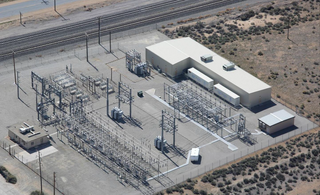
A battery storage power station is a type of energy storage power station that uses a group of batteries to store electrical energy. Battery storage is the fastest responding dispatchable source of power on electric grids, and it is used to stabilise those grids, as battery storage can transition from standby to full power in under a second to deal with grid contingencies.
The Tesla Megapack is a large-scale rechargeable lithium-ion battery stationary energy storage product, intended for use at battery storage power stations, manufactured by Tesla Energy, the clean energy subsidiary of Tesla, Inc.

Lake Gault is a small glacial lake in South Westland, New Zealand, near the township of Fox Glacier. A walking track from Lake Matheson leads to the lake, which is surrounded by mature native forest. A small hydro-electric power plant was constructed piping water from the lake to power a gold mining dredge at Gillespies Beach. Endangered Ōkārito kiwi (rowi) have been released into the wild around Lake Gault.

Dawsonia longiseta is a species of moss in the family Polytrichaceae endemic to eastern Australia.

The Big Rimu Walk is a nature trail near Karamea, located in Kahurangi National Park on the West Coast of the South Island of New Zealand. A short walk of 1.1 kilometres (0.68 mi) through regenerating bush leads to a large rimu tree that is 36 metres (118 ft) tall with a trunk over two metres in diameter and estimated to be over 1,000 years old. Other smaller rimu in the area were logged during the 1940s but this large tree was left.




